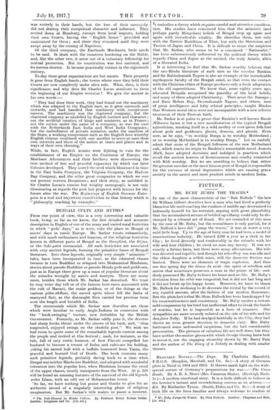BENGALI CULTS AND MYTHS..
FROM one point of view, this is a very interesting and valuable book, bring, so far as we know, the first detailed and accurate description in English of one of the many and varied rural festivities in which " gods' days," as it were, take the place in Bengal of saints' days in rustic Europe. Mr. Sarkar treats exhaustively, and with much enthusiasm and humour, of the religious festivities known in different parts of Bengal as the Gam phlrd, the aljan. or the ,Sabi-ystrd ceremonial. All such festivities are associated with very ancient legends, forming the primitive bases of Bengali literature. Into these legends, originally very simple " animistic " tales, have been incorporated in time, as the mhicated classes became in turn Buddhist or relapsed into Braluninical Hinduism, stories about pseudo-Buddhist or pseudo-Hindu gods and goddesses, just as in Europe there grew up a mass of popular literature about the miracles wrought by mints and martyrs. There are many more, besides those which Mr. Sarkar has described. We trust ho may some day toll ue of the famous boat-races associated with the cult of Manasi, the snake goddess, or of the doings at the various pigha.sthiinas, the sacred spots where fell the limbs of martyred Sal, as the distraught Siva carried her precious form over the length and breadth of India.
The ceremonials which Mr. Sarkar now describes are those which were familiar to .early iinglo.Indians in connexion with the " hook-swinging " torture, now forbidden by the British Government. Formerly, as Mr. Sarkar oddly puts it, the devotee had sharp hooks thrust under the sinews of hie back, and, "thus suspended, enjoyed swings on the chadaka poet." We wish we had room to quote some of the remarkable legends current among the people and recited at this festival ; such, for instance, as the tale, tuff of racy rustic humour, of how Parvati compelled her husband to become a tenant of Indra and cultivate hie holding, risking his sacred bull with a buffalo borrowed from Yams, the graceful and learned God of Death. The book contains many such primitive legends, probably dating back to a time when Bengal was neither Hindu nor Buddhist, and adopted with wonderful toleration into the popular lore, when Hinduism became the creed of the upper classes, mostly immigrants from the West. At p. 228 will be found an amusing instance of the survival of the old legends ender Islam, with an odd use of Mohammedan terms.
'So far, we have nothing but praise and thanks to give for an authentic record of a singularly interesting phase of religious imagination. But Mr. Seeker's title makes sae pause a moment.
• The Folk-Element in Man Culture. By Professor Benny Kumar Sarkar. London : Long:mans and Co. 1155. =LI
It embodies a theory which requires careful and attentive considera- tion. His studios have convinced him that the animistic (and perhaps partly Mongolian) beliefs of Bengal crop up again and again with ineradicable vitality. He identifies them, not only with the Tantric Buddhism of Tibet, but with the Shintoism and Taoism. of Japan and China. It is difficult to resist the suspicion that Mr. Sarkar, who seems to be a convinced " Nationalist," has been subconsciously influenced by the political theory which regards China and Japan as the natural, the truly Asiatic, allies of a liberated India.
It is interesting to find that Mr. Saslow sturdily believes that the neo-Hindu literature of such men as the novelist Bantam and Sir Rabindranath Tesoro is also an example of the ineradicable mythopoeic faculty of the Bengali mind, so that oven the contact with the Christian ethics of Europe produces only a fresh adaptation of the old superstitions. We know that, some eighty years ago, educated Bengalis recognized the puerility of the local beliefs, and many of them adopted Christianity. Then arose the Sainajes ; and Ram Mohan Roy, Devendranath Tagore, and others, men of groat intelligence and lofty ethical principles, taught Hindus that Western moral ideas were not incompatible with a now eclectic treatment of their Protean faith.
Mr. Sacker is at pains to prove that Bankim'e well-known Bands Mamma hymn is but a new manifestation of the typical Bengali agnosticism, masking itself in a wild medley of ever-green folk-lore about gods and goddesses, ghosts, demons, and ghouls. Even now, as he says, "to worship Durga ie to worship Motherland ; or to worship Motherland is to worship Durga." Lot us ruefully admit that some of the Bengali followers of the new Motherland cult, which traces its origin to Bankim's remarkable novel Armada Math, have adopted doctrines and indulged in practices which recall the ancient horrors of licentiousness and cruelty connected with Kali worship. But we are unwilling to believe that either the greatest novelist or the most famous poet of Bengal is responsible for the excesses of moral degenerates which are causing grave anxiety to the sanest and moat prudent minds in modern India.


























 Previous page
Previous page